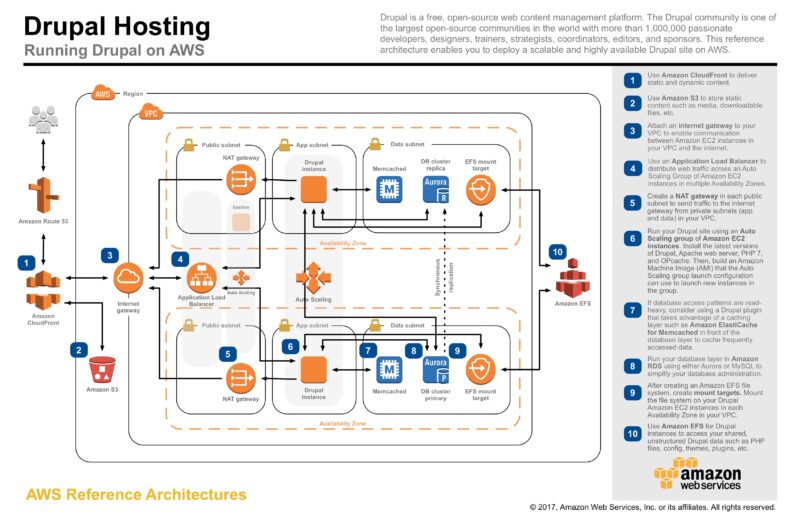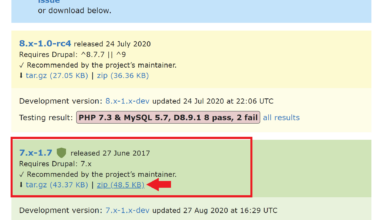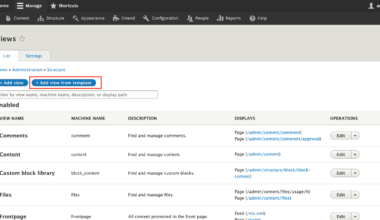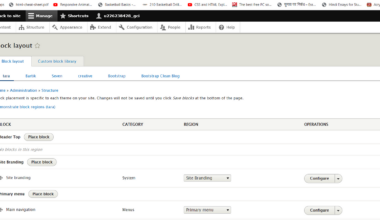Introduction: Drupal and AWS
As the internet continues to become more complex, businesses need scalable and flexible solutions that can adapt to changing demands. Fortunately, Drupal and Amazon Web Services (AWS) provide a powerful combination of tools that can help businesses meet their online needs.
Drupal is a free and open-source content management system (CMS) that allows users to easily create and manage websites. It is highly customizable, with a vast library of modules and themes that can be used to enhance the functionality and design of a website. AWS, on the other hand, provides a range of cloud computing services that can be used to host and manage web applications.
By combining Drupal and AWS, businesses can take advantage of the benefits of both platforms. Drupal provides a powerful CMS that can be used to create and manage content, while AWS provides a range of cloud computing services that can be used to host and scale web applications.
In this article, we will explore the benefits of hosting Drupal on AWS, the AWS services that are most useful for Drupal development, and best practices for using Drupal on AWS. We will also provide examples of how businesses have successfully used Drupal and AWS to achieve their online goals.
Benefits of Hosting Drupal on AWS
There are numerous benefits to hosting Drupal on AWS, including:
Scalability
One of the biggest advantages of hosting Drupal on AWS is the ability to scale resources up or down based on demand. AWS provides a range of services, such as Amazon Elastic Compute Cloud (EC2) and Amazon Elastic Load Balancer (ELB), that can be used to automatically adjust resources based on traffic levels. This allows businesses to handle traffic spikes without worrying about downtime or slow page load times.
Reliability
AWS is known for its high level of reliability. The platform is designed to provide 99.99% uptime, and it includes multiple layers of redundancy to ensure that websites and applications remain available even if one or more servers fail. With AWS, businesses can be confident that their website will be available to users at all times.
Cost-Effectiveness
Hosting Drupal on AWS can be cost-effective for businesses of all sizes. AWS offers a pay-as-you-go pricing model, which means that businesses only pay for the resources they use. This can be especially beneficial for businesses that experience spikes in traffic, as they can scale up resources as needed without incurring significant costs.
Security
AWS provides a range of security features that can help businesses protect their websites and applications from cyber threats. This includes features such as AWS Identity and Access Management (IAM) and Amazon Virtual Private Cloud (VPC), which allow businesses to control access to their resources and create a secure network environment.
Flexibility
AWS provides a range of services that can be used to customize and optimize Drupal websites and applications. For example, businesses can use Amazon Relational Database Service (RDS) to manage their Drupal databases, or Amazon CloudFront to distribute content globally and improve website performance. With AWS, businesses can create a custom infrastructure that meets their specific needs.
Overall, hosting Drupal on AWS provides businesses with a range of benefits, including scalability, reliability, cost-effectiveness, security, and flexibility. By taking advantage of these benefits, businesses can create a highly customizable and scalable website or application that can meet their online needs.
AWS Services for Drupal Development
AWS provides a range of services that are specifically designed to support Drupal development. Some of the most useful services for Drupal on AWS include:
Amazon Elastic Compute Cloud (EC2)
Amazon EC2 is a web service that provides resizable compute capacity in the cloud. This service allows businesses to easily launch and manage virtual servers, which can be used to host Drupal websites and applications. EC2 provides a range of instance types, which are optimized for different workloads. By using EC2, businesses can easily scale their infrastructure up or down based on demand, without having to worry about hardware limitations.
Amazon Relational Database Service (RDS)
Amazon RDS is a web service that makes it easy to set up, operate, and scale a relational database in the cloud. This service can be used to manage Drupal databases, which are essential for storing website content and user data. RDS supports a range of database engines, including MySQL, PostgreSQL, and MariaDB. With RDS, businesses can easily manage their databases, without having to worry about hardware provisioning, software patching, or backups.
Amazon Elastic Load Balancer (ELB)
Amazon ELB is a web service that automatically distributes incoming traffic across multiple instances. This service can be used to improve website performance and availability, by balancing traffic across multiple Drupal instances. ELB supports both HTTP and HTTPS traffic, and it can be used to automatically scale resources up or down based on traffic levels.
Amazon CloudFront
Amazon CloudFront is a content delivery network (CDN) that can be used to distribute content globally. This service can be used to improve website performance, by caching content at edge locations close to website users. CloudFront supports both static and dynamic content, and it can be used to deliver content over both HTTP and HTTPS.
Amazon S3
Amazon S3 is a web service that provides scalable object storage in the cloud. This service can be used to store website assets, such as images, videos, and documents. S3 provides a highly durable and available storage infrastructure, which can be accessed from anywhere in the world. With S3, businesses can easily store and retrieve website assets, without having to worry about hardware limitations or data loss.
In addition to these services, AWS provides a range of
Best Practices for Drupal on AWS
When hosting Drupal on AWS, it is important to follow best practices to ensure that your website or application runs smoothly and efficiently. Here are some best practices to consider:
Use Autoscaling
Autoscaling is a powerful feature of AWS that can be used to automatically adjust resources based on traffic levels. By using autoscaling, businesses can ensure that their website or application can handle any spikes in traffic without experiencing downtime or slow page load times. To use autoscaling with Drupal, businesses can use Amazon Elastic Compute Cloud (EC2) and Amazon Elastic Load Balancer (ELB) to automatically add or remove instances based on traffic levels.
Implement Caching
Caching can be used to improve website performance by storing frequently accessed information in memory, where it can be accessed quickly. Drupal supports a range of caching options, including internal caching, page caching, and block caching. AWS also provides a range of caching solutions, including Amazon CloudFront and Amazon ElastiCache. By using caching, businesses can improve website performance and reduce server load.
Use a Content Delivery Network (CDN)
A content delivery network (CDN) can be used to distribute content globally, which can help improve website performance for users located far away from the website’s server. AWS provides Amazon CloudFront, a CDN service that can be used to deliver content quickly and efficiently. By using CloudFront, businesses can reduce latency and improve website performance for users located around the world.
Backup Data Regularly
Backing up data regularly is essential to ensure that website content and user data is not lost in the event of a disaster. AWS provides a range of backup solutions, including Amazon S3 and Amazon Glacier. By using these solutions, businesses can ensure that their website data is always backed up and can be easily restored in the event of data loss.
Secure Your Application and Data
Security is a critical aspect of website development and hosting. AWS provides a range of security features that can be used to secure your Drupal application and data. This includes features such as AWS Identity and Access Management (IAM), which can be used to control access to AWS resources, and Amazon Virtual Private Cloud (VPC), which can be used to create a secure network environment. Businesses should also ensure that their Drupal application is regularly
Final Thought: Why Drupal and AWS are a Winning Combination
In today’s fast-paced digital landscape, businesses need a scalable and flexible online presence that can adapt to changing demands. Drupal and AWS provide the ideal combination of tools to meet these needs. By using Drupal as the CMS and AWS as the cloud computing platform, businesses can create a highly customizable and scalable website or application that can meet their online goals.
The benefits of hosting Drupal on AWS are numerous, including scalability, reliability, cost-effectiveness, security, and flexibility. With AWS, businesses can easily scale their infrastructure up or down based on demand, without having to worry about hardware limitations. This ensures that businesses can handle traffic spikes without worrying about downtime or slow page load times. Additionally, AWS provides a high level of reliability and security, which can help businesses protect their website and application from cyber threats.
AWS services for Drupal development are also specifically designed to support Drupal development. By using services such as Amazon EC2, Amazon RDS, Amazon ELB, Amazon CloudFront, and Amazon S3, businesses can create a custom infrastructure that meets their specific needs. These services can be used to manage databases, distribute content globally, improve website performance, and store website assets.
To ensure the smooth and efficient running of Drupal on AWS, businesses should follow best practices such as using autoscaling, implementing caching, using a CDN, backing up data regularly, and securing their application and data. By following these best practices, businesses can ensure that their website or application runs smoothly and efficiently, without any issues or downtime.
In conclusion, Drupal and AWS are a winning combination for businesses looking to create a scalable and flexible online presence. By taking advantage of the benefits of both platforms and following best practices, businesses can create a highly customizable and scalable website or application that can meet their online goals.






















